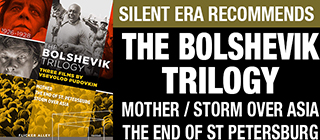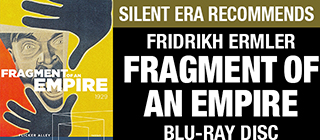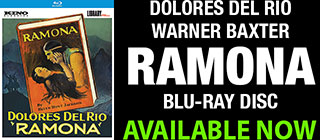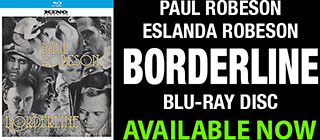Silent Era Home Page > Home Video > A Sixth Part of the World

Reviews of silent film releases on home video.
Copyright © 1999-2025 by Carl Bennett
and the Silent Era Company.
All Rights Reserved. |
|
A Sixth Part
of the World
[Sestaja cast’ mira]
(1926)
|
Perhaps best known for Man with the Movie Camera (1929), director Dziga Vertov’s earlier assemblage documentary Sestaja cast’ mira [A Sixth Part of the World] (1926) positions itself first as a condemnation of some Soviet citizens’ fascination with Western culture while workers toil to maintain the economy for the good of the Soviet Union, later as a celebration of the diversity of cultures and achievements of Soviet citizens.
At first revelling in a counterpoint of contrasts, with sequences of the well-to-do people of large cities cut against shots of poor ethnic peoples toiling, the film slowly coalesces into a parade of celebratory images, of simple country peoples working and playing, to make its central and affirming statement about the human nobility of diversity and hard labor.
Justly celebrated as an example of pure cinema, representing an artform that cannot be approached or replicated in other media, Vertov’s work often (as it does in A Sixth Part of the World) transcended mere assemblage to become a cohesive epic visual tone poem.
The film is also quite valuable as an anthropological visual document of the remote cultures and natural resources of the Soviet Union of the 1920s, capturing as it does many of the daily activities of its diverse citizens at work and play.
— Carl Bennett
|
 Edition Filmmuseum Edition Filmmuseum
2009 DVD edition
Sestaja cast’ mira [A Sixth Part of the World] (1926), black & white, 73 minutes, not rated, with Odinnadcatyj [The Eleventh Year] (1928), black & white, 53 minutes, not rated, and Im Schatten der Maschine (1928), black & white, 22 minutes, not rated.
Edition Filmmuseum, 53, UPC/EAN 4-260100-330537.
One single-sided, dual-layered, Region 0 PAL DVD disc (two DVDs in the set); 1.33:1 aspect ratio picture in windowboxed 4:3 (720 x 576 pixels) interlaced scan image encoded in SDR MPEG-2 format at 6.5 Mbps average video bit rate (capable of progressive scan upscaling to ? fps); Dolby Digital (AC3) 2.0 stereo sound encoded at 224 Kbps audio bit rate; Russian language intertitles, optional German and English language subtitles; 5 chapter stops; 32-page insert booklet; standard two-disc DVD keepcase; €29,95.
Release date: December 2009 (second edition, August 2010; third edition, November 2014).
Country of origin: Germany
Ratings (1-10): video: 5 / audio: 7 / additional content: 7 / overall: 6.
|

This PAL DVD edition has been produced by Österreichisches Filmmuseum, Vienna, from a windowboxed high-definition video transfer from a very-good 35mm preservation positive duplicated in the late 1960s by Gosfilmofond film archive and gifted to the museum. The film has apparently not survived in the best condition as the original source print was speckled and dusty, with a moderate amount of emulsion scuffing and scratches, frame jitters, all retained in the preservation print. The print is comparable in visual quality to other surviving Soviet films of its vintage. Being an assemblage of existing and new cinematography, the film is uneven in cinematographic quality with some shots being contrastier and less-detailed than others. The surviving print appears to have be duplicated (perhaps a small number of times) leaving, in some shots, a visual quality akin to a vintage 16mm reduction print. Many shots, however, maintain a broad greytones range and very-good picture detail. The 25-frames-per-second HD video transfer has captured the visual qualities of the source print, rough as it is, and the DVD disc mastering retains a reasonably filmlike picture when viewed on equipment capable of progressive scan playback.
Some care has been taken to restore a few moments of footage with varied framelines (in relation to the print’s sprocket holes), digitally correcting any framing mislignments in the transfer.
The film is presented with a fine music score composed by Michael Nyman and performed by a small orchestra. The music sets the tone for the film in sometimes somber moods, and at other times in driven, mechanical repetition.
Among the supplemental material is a 32-page bilingual booklet, with essays by Barbara Wurm, Thomas Tode, Adelheid Heftberger, Aleksandr Derjabin, Michael Loebenstein and Alexander Horwath, and DVD-ROM content, with additional information about Vertov’s “Phrases” in Odinnadcatyj, insights into the film’s intertitles, the “Blum Affair,” and the “Digital Formalism” Vertov on DVD project.
This high-quality edition is recommended to Vertov enthusiasts, and is currently the only available DVD home video edition of A Sixth Part of the World.
North American collectors will need a region-free PAL DVD player capable of outputting an NTSC-compatible signal to view this edition.
|
|
This Region 0 PAL DVD edition is available directly from . . .
|

|
|
|
Other silent era DZIGA VERTOV films available on home video.
Other RUSSIAN and SOVIET FILMS of the silent era available on home video.
|
|

LINKS IN THIS COLUMN
MAY TAKE YOU TO
EXTERNAL WEBSITES
•
















•
|




































